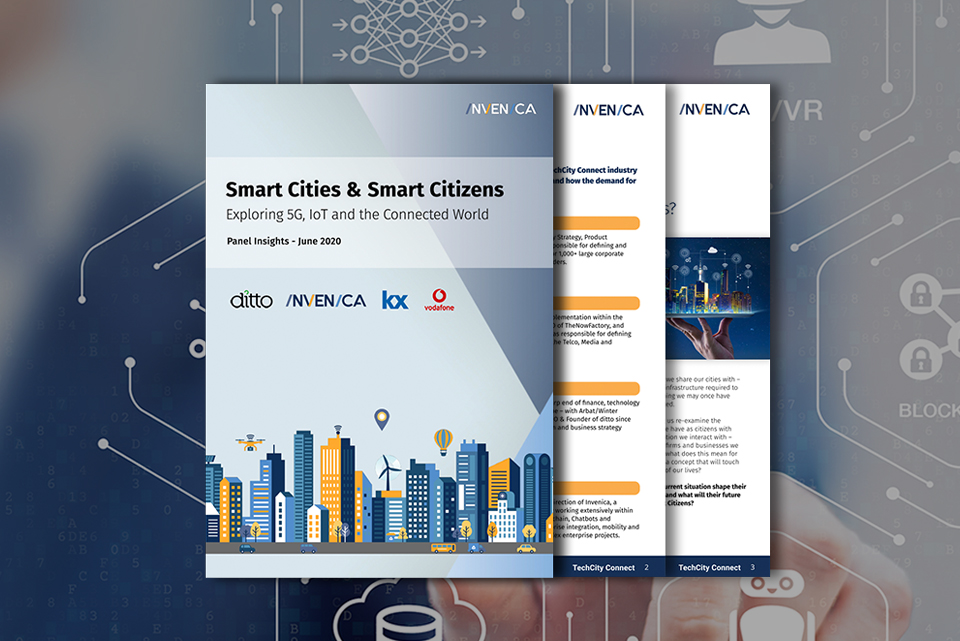As we are fast approaching a new decade we spoke to Gareth Mee, CEO at invenica discussing Blockchain innovation & disruption in Media & Telecoms. In this podcast we touch upon the exciting projects revealed this year and explore how telcos can harness the potential of DLT in 2020.
Invenica is a systems integrator specializing in emerging technology, with 15 years heritage developing enterprise-grade applications for both business to business and business to consumer in large corporations, helping them solve their business problems and challenges with emerging tech.
We have a very heavy presence in media and Telecom. Invenica have been helping the media and telecom industry implement new products and services, streamline and improve their operations for many years now, from launching the first radio streaming music service across Europe, to onboarding OTT providers and allowing telcos to charge to bill.
What exciting projects have you seen in telcos and other industries using emerging technology?
There’s some interesting things that are going on in the media and telco world surrounding emerging tech right now. We’ve all seen the operators pushing 5G to the consumer and that opens up a world of opportunity in terms of rich media communications, gaming, films etc. Operators will continue to push that technology.
I think you can split these things into technology that we can use to help the operational efficiency of the business. We are advising and implementing automation around processes, a typical example of this would be in the customer service space where we’re trying to implement omni-channel Virtual Assistants to automate customer service and conversational AI that will allow companies to do that efficiently. Reducing operational cost and allowing your workforce to complement the Machine and to improve and provide a rich and improve service for your customers.
Distributed ledger technology (DLT) and blockchain is an interesting space and there’s many POCs taking place across the telco industry. Right now, I think that the media and telco industry are trying to work out what the best use cases are and we’re helping our customers identify those, and again you can split those into business support projects or operational support projects and customer facing products and service. On the operational side then there’s the you know the liquidity is important important to any telco carrier so automated financial reconciliation using blockchain is a very strong use case this could be as simple as automating the financial reconciliation for your ATT providers or taking that step further it could be crossed across border roaming between operators and there’s a lot of work going on in terms of exploration in that area.
Taking it further taking it to the product and service side, we’re doing working there with a particular operator arraigned identity and how you might monetize identity in KYC by collaborating with other partners. If you think about the telco, then it’s in a privileged position in terms of the information and data that holds on on individuals and consumers. In the future you will see the consumer owning their own identity and choosing which services that they wish to be provided with and as part of that process that will be kyc process we’re partners collaborate over a blockchain to identify and then provision the consumer with the service so I think if you look at that then it’s an extension of what the telcos will already do it from an OTT basis you may take that one step further and maybe in the future working with digital communities with with digital asset or digital currency where consumers can access whatever service they want through collaboration partners as an example.
There is a bigger topic around business models of the future you, for many many years there’s been a debate about the merge of banking in telcos. We’ve already seen this is an existence or in Orange is running a very successful banking in France, there are opportunities to take this a step further with the digital currency and we’ve seen some collaborating collaborations exploring this for example so not only are you creating a digital community where your users can procure services from a collaboration of partners, but essentially you could allow a digital currency to enable transaction trading within that community.
Why are telcos poised to harness the power of emerging tech and how are telcos working in partnership with other sectors, such as financial services?
Leading on from the discussion we’re having around telco and banking then there are some key points to elaborate on. Obviously the telcos are in a unique position because it knows where you are and essentially it knows what you’re doing, so if you combine that with the financial risk profile then you have the ability to provide a proactive and personalised service to any one consumer, making it around financial planning financial wellness alongside the promotion of the right products and services for them, so that’s just an extension of that particular use case or conversation.
Banking in telco is essentially nothing new, if you look at Africa then you know we’ve had mobile money for some time and interestingly enough; in the regions where Mobile Money has been most successful, for example Kenya, is where the telco has been responsible for that service and promoted that service. In other countries such as Nigeria, it’s the banks that have done it. But the telcos are more digitally aware or mature, and that enables them to provide or produce a better service.
So mobile money and pays is nothing new, but right now that works with the banks underwriting it., so you have to have a bank account. But if you think about the amount of people, not just in the developing world but in the UK and Europe, then you know there’s a lot of people that are what we would call un bankable, don’t have bank accounts. Explore that use case, or business model further, there an opportunity for telcos to offer consumers the unbankable a bank service that is underwritten by a digital currency. I know we’ve had that conversation with other partners and some customers it’s an ongoing debate, it maybe some time away but certainly we’re having some more conversations that will be available, some webinars and some physical events and certainly some of these use cases and topics arraigned DLT and currency that we’re going to be talking about in the coming months.
Can you share use cases around data transfer and security?
There are other things that are happening, from an innovation perspective we talked about security and there are use cases that we discussed around 5G and securtising cross-border data and there are use cases that are being explored for DLT and blockchain.
Those are certainly being explored right now going back to the location; we talked about location in reference to offering a personalized financial service potentially consumers but there’s other use cases there as well. Looking at security, the telco has data about what are you doing where, so it can build up patterns of your use consumption around a particular device or phone and that is useful, for example in families where you might spot an irregular pattern of use, maybe for one of your siblings or children and that’s quite important from a security perspective. There’s also a business use case for managing the consumption of certain types of data; I’ve seen some very interesting technology, recently from some business-to-business MVO players where they cannot they can split down content into categories and even further into individual sites that people are using.There’s lots going on with both the bigger picture and the future operating business model which will continually be discussed for a telco finance and treasury perspective. Then there’s conversations about how can we release capital, because capital is king for the telco and you know, is the answer to that tokenizing in providing digital digital assets to do that arrange roaming on financial reconciliation area partners?
How is emerging tech helping to achieve better customer service?
Obviously what’s going on in the more immediate landscape today you know around new products and services being provided by 5G and the ability that that new network bandwidth gives to media and telco providers to provide richer services for their consumers, and of course then touching on the operational businesses support side of your business.
I think I talked about the savings that the automation AI would drive and we use the customer service explain or example but it’s not just about operational savings it’s about improved customer service so if I call into a contact center and the first thing I hear is ‘hello how may I help you’, my call has been answered for the first time, I’m not in it I’m not in a DTMF queue where I’m being asked to press one two three four for. I talk to the virtual agent as though I talk to a human being, and for 70% of common use cases the virtual agent can resolve my query but in whatever communication style I choose whether that’s voice whether that’s messenger whether that’s SMS and ultimately we’re talking about improved customer service and therefore improved customer retention. That’s imperative for the telco, in many cases in many parts of the world that there’s volumes of calls that don’t even get answered and called drop-off so this in its very essence improve it means that that first step of customer service is achieved.
What is on the horizon for Invenica operating in the DLT space?
I’m going to come back to DLT because that’s gonna be a specific focus of ours for the coming months. Talking specifically about use cases within the media and telco industry and we will
be doing webinar and white paper later in the year on that topic. It’s interesting because everyone’s trying to work out the best use, there’s many different pilots and proof of concepts going on and across the industry and very exciting ones, it’s an interesting time. DLT will be a significant disrupting technology and we talked about DLT because it is not just blockchain, there’s many platform providers out there that are producing some pretty good tech tech platforms.
I think no one really knows what the predominant technology platform will be in the future and it’s very important that you make the right choice in terms of platform or or indeed you you ensure that that platform is interchangeable in the future. I’ve read some interesting reports recently so I can’t claim this is my own my own thinking, but it’s certainly right, you know DLC is not an out of the box product so unlike 5G which is an increase in bandwidth which relations to do some really exciting things for the consumer and business to business applications. With IOT and edge computing, the application is DLT that businesses are using to try and solve certain use cases, it’s trying to pick the most or the best use case for your business and then underlying that the best DLT team for that typical use case.
This is where Invenica is investing a lot of time advising customers, not just in isolation, we’re collaborating with our partners to do that. The whole concept of blockchain or DLT is about collaboration between business partners and that should certainly be the same with the technology and the application of the technology, so it’s not just Invenica talking when we’re talking, we’re talking in consultation and in collaboration with our partners and we’ll be doing more of that in the future.




